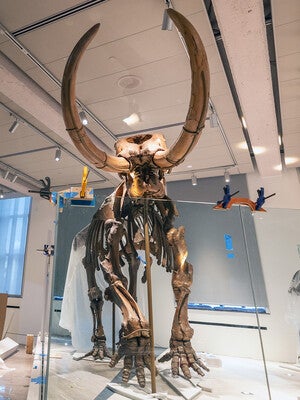Following a transformative four-year renovation, the Yale Peabody Museum reopens to the public on Tuesday, March 26, at 10 a.m., with rejuvenated galleries, reimagined exhibits, and refurbished dinosaurs, including a towering Brontosaurus with some new pep to its step.
Guests can pre-book visits on the Peabody's website. The museum will use a reservation system for the first 30 days after opening to manage anticipated crowds.
The renewed Peabody - which now offers free admission for all visitors - is a dynamic center of participatory learning, groundbreaking research, and more accessible exhibitions that present the ever-changing story of life on Earth to a new generation of schoolchildren, university students, and museum-goers from New Haven, the region, and the world.

"I am delighted to see the Yale Peabody Museum open after undergoing a comprehensive renovation that makes it better able to serve members of the Yale community, K-12 students from our home city, and visitors from the region and beyond," said Yale President Peter Salovey. "I am particularly impressed by all the ways the museum is expanding teaching and research opportunities on campus - from new classrooms and a student-curated exhibition space to increased storage and research facilities.
"Of course, as a long-time New Haven resident, I am especially looking forward to seeing young people from the surrounding area benefit from the expanded and more accessible exhibitions and the new education center for public school programs."
The renovation, made possible by a landmark $160 million gift from philanthropist Edward P. Bass '68 and designed by Connecticut-based Centerbrook Architects and Planners, expanded the museum's galleries by more than 50%. The expansion provides additional exhibition space for the Peabody's collection of 14 million objects - fossils, meteorites, and anthropological artifacts among them - as well as new research spaces, classrooms equipped with the latest audio-visual technology, and a new education center for K-12 students from the New Haven area.
Through the generous support of Bass and other donors, the Peabody joins the Yale University Art Gallery and the Yale Center for British Art in offering free public admission in perpetuity.
"Whether you have been coming to the Peabody for decades or have just discovered us for the first time, we want you to feel welcome, excited, and inspired from the moment you walk through the doors," said Peabody Director David Skelly, the Frank R. Oastler Professor of Ecology at Yale School of the Environment and Yale's Faculty of Arts and Sciences. "This renovation has transformed every exhibit in the museum, but I think its biggest impact will be the ways it helps us engage with audiences and communities in much more meaningful ways. By removing the barrier of an admission fee, we want our guests - and especially our New Haven neighbors - to visit us often and have a different experience each time."

The renovation expanded the museum's classroom space three-fold. New imaging, sound, and 3D-printing studios will allow students to work hands-on with collection objects using the most advanced technology.
The exhibition galleries, now represented on three floors instead of two, are brighter and easier to navigate. The third-floor galleries, including the David Friend Hall mineral and gem gallery, will open on a phased schedule later this spring.
The museum's famed dinosaur and prehistoric mammal fossils - including the first Brontosaurus, Stegosaurus and Triceratops specimens ever discovered - were cleaned, mended, and remounted in dynamic new poses that reflect the modern scientific consensus that dinosaurs were alert and lively animals, not the plodding brutes depicted in old textbooks and 20th-century popular culture. For example, the museum's 65-foot-long Brontosaurus once again towers at the center of the Burke Hall of Dinosaurs, but the hulking herbivore appears newly nimble and energetic. Its tail, which previously rested on the ground, was lengthened and raised into the air, allowing guests to walk beneath it. Its head and neck are repositioned in an inquisitive, birdlike manner.

Near the entrance of an adjoining hall, the American mastodon, previously displayed in profile behind glass, wields its mighty tusks in the open, seemingly ready to stride from its platform.
In a scene suspended from the ceiling of the museum's spacious new Central Gallery, Archelon, the largest turtle ever documented, flees a hungry mosasaur, a predatory marine lizard from the Late Cretaceous. The same scene could have played out over and over in the vast inland sea that once split the North American continent in two.

And while the dinosaur and prehistoric fossil collections have held center stage since the museum's founding in 1866, the renovation has created new space for exhibiting more of its cultural, anthropological, and other scientific collections, including never-before displayed artifacts and contemporary art. For instance, an eclectic assortment of scientific tools from the Peabody's History of Science and Technology Collection, including Yale's first microscope - purchased in 1735 - are exhibited in a second-floor gallery.
Throughout the museum, exhibit labels and other text are tailored to be more accessible and interesting to a wider range of audiences. Museum ambassadors will be stationed alongside exhibits to share insights, answer questions, and create a sense of belonging for all communities. The Peabody is fully accessible to people with disabilities. Visitors will also enjoy a new gift shop and food concession.
Hours of Operation:
Mondays - Closed
Tuesdays through Saturdays - 10am to 5pm
Sundays - 12pm to 5pm






